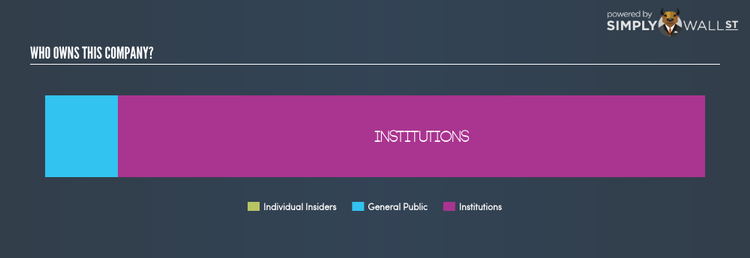Breaking Down American International Group Inc’s (NYSE:AIG) Ownership Structure

In this article, I’m going to take a look at American International Group Inc’s (NYSE:AIG) latest ownership structure, a non-fundamental factor which is important, but remains a less discussed subject among investors. When it comes to ownership structure of a company, the impact has been observed in both the long-and short-term performance of shares. Since the same amount of capital coming from an activist institution and a passive mutual fund has different implications on corporate governance, it is a useful exercise to deconstruct AIG’s shareholder registry.
View our latest analysis for American International Group
Institutional Ownership
In AIG’s case, institutional ownership stands at 88.85%, significant enough to cause considerable price moves in the case of large institutional transactions, especially when there is a low level of public shares available on the market to trade. However, as not all institutions are alike, such high volatility events, especially in the short-term, have been more frequently linked to active market participants like hedge funds. For AIG shareholders, the potential of this type of share price volatility shouldn’t be as concerning as hedge fund ownership is is not significant,indicating few chances of such sudden price moves. While that hardly seems concerning, I will explore further into AIG’s ownership type to find out how it can affect the company’s investment profile.
Insider Ownership
Another important group of shareholders are company insiders. Insider ownership has to do more with how the company is managed and less to do with the direct impact of the magnitude of shares trading on the market. A stake of less than 1% in AIG is relatively small, though at least there is still some alignment of interest with shareholders. A higher level of insider ownership has been found to reflect the choosing of projects with higher return on investments compared to lower returning projects for the sake of expansion. I will also like to check what insiders have been doing recently with their holdings. Insider buying may be a sign of upbeat future expectations, however, selling doesn’t necessarily mean the opposite as insiders may be motivated by their personal financial needs.
General Public Ownership
A big stake of 11.07% in AIG is held by the general public. This size of ownership gives retail investors collective power in deciding on major policy decisions such as executive compensation, appointment of directors and acquisitions of businesses. This level of ownership gives retail investors the power to sway key policy decisions such as board composition, executive compensation, and potential acquisitions. This is a positive sign for an investor who wants to be involved in key decision-making of the company.
Next Steps:
The company’s high institutional ownership makes margin of safety a very important consideration to existing investors since long bull and bear trends often emerge when these big-ticket investors see a change in long-term potential of the company. This will enable shareholders to comfortably invest in the company while avoid getting trapped in a sustained sell-off that is often observed in stocks with this level of institutional participation. However, ownership structure should not be the only focus of your research when constructing an investment thesis around AIG. Rather, you should be examining fundamental factors such as American International Group’s past track record and financial health. I urge you to complete your research by taking a look at the following:
1. Future Outlook: What are well-informed industry analysts predicting for AIG’s future growth? Take a look at our free research report of analyst consensus for AIG’s outlook.
2. Past Track Record: Has AIG been consistently performing well irrespective of the ups and downs in the market? Go into more detail in the past performance analysis and take a look at the free visual representations of AIG’s historicals for more clarity.
3. Other High-Performing Stocks: Are there other stocks that provide better prospects with proven track records? Explore our free list of these great stocks here.
NB: Figures in this article are calculated using data from the last twelve months, which refer to the 12-month period ending on the last date of the month the financial statement is dated. This may not be consistent with full year annual report figures.
To help readers see pass the short term volatility of the financial market, we aim to bring you a long-term focused research analysis purely driven by fundamental data. Note that our analysis does not factor in the latest price sensitive company announcements.
The author is an independent contributor and at the time of publication had no position in the stocks mentioned.

